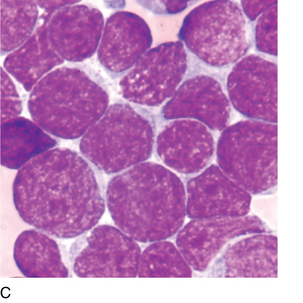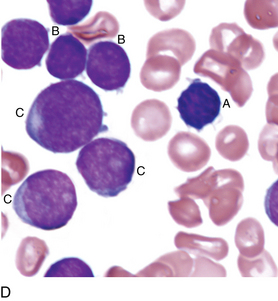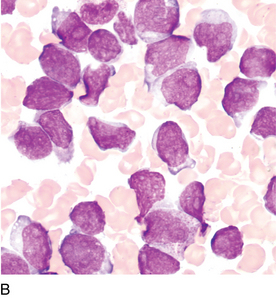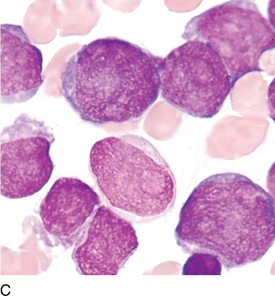16 Precursor lymphoid neoplasms
The World Health Organization classifies precursor lymphoid neoplasms into two major groups: B lymphoblastic leukemia/lymphoma and T lymphoblastic leukemia/lymphoma. Leukemia is primarily a disease of peripheral blood and bone marrow, whereas the primary site of involvement for lymphoma is the lymph system. Because this is an atlas of blood cells, only the leukemia morphology will be presented. Acute lymphoblastic leukemia (ALL) is not classified morphologically or by cytochemistry, but by a combination of cytogenetic profiles, genotype, and immunophenotype. B lymphoblastic leukemia is subdivided into seven subtypes that are associated with recurrent genetic abnormalities (Box 16-1). Those cases of B-ALL that do not fall within one of these groups are classified as B lymphoblastic leukemia, not otherwise specified. Although 50% to 70% of patients with T-ALL do have abnormal karyotypes, none of the abnormalities is clearly associated with distinctive biologic features, and thus T-ALL is not further subdivided.
B lymphoblastic leukemia/lymphoma with t(9;22)(q34;q11.2); BCR-ABL1
B lymphoblastic leukemia/lymphoma with t(v;11q23); MLL rearranged
B lymphoblastic leukemia/lymphoma with t(12;21)(p13;q22); TEL-AML1(ETV6-RUNX1)
B lymphoblastic leukemia/lymphoma with hyperdiploidy
B lymphoblastic leukemia/lymphoma with hypodiploidy
B lymphoblastic leukemia/lymphoma with t(5;14)(q31;q32); IL3-IGH
B lymphoblastic leukemia/lymphoma with t(1;19)(q23;p13.3); E2A-PBX1 (TCF3-PBX1)
From Swerdlow SH, Campo E, Harris NL, et al, editors: WHO classification of tumours of haematopoietic and lymphoid tissues, ed 4, Lyon, France, 2008, IARC Press.
Lymphoblasts may be either small and homogeneous or large and heterogeneous. Further testing is needed to determine the phenotype and genotype.













